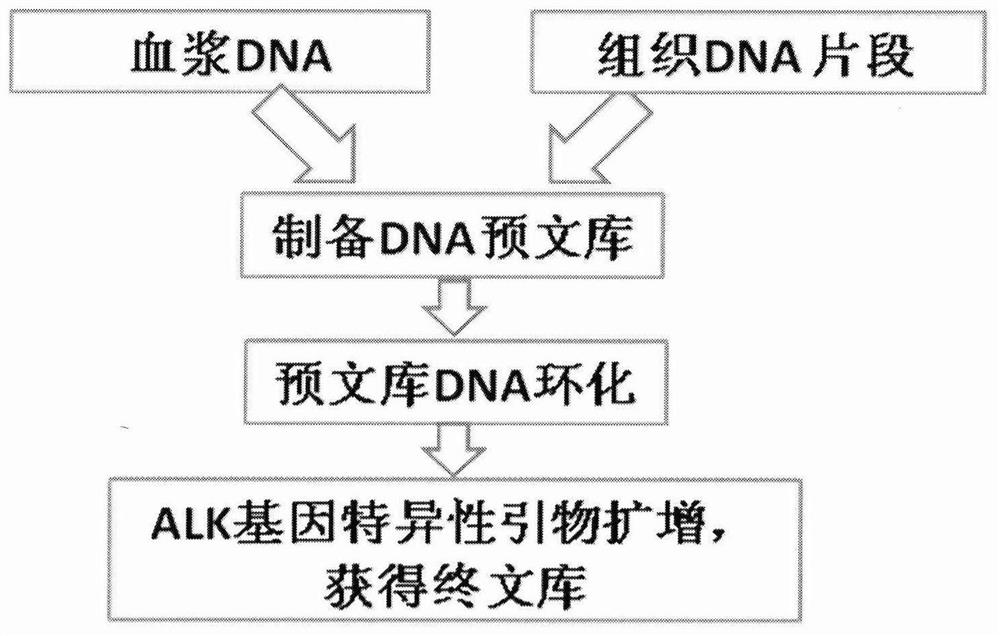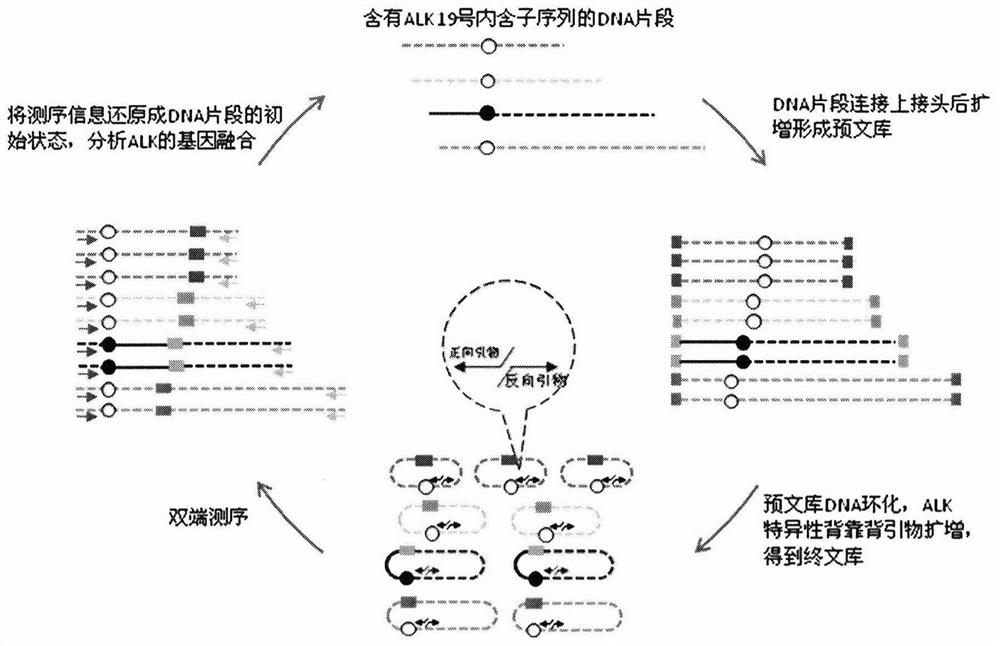A method and kit for constructing alk gene fusion mutation detection library
A gene fusion, mutation library technology, applied in chemical libraries, biochemical equipment and methods, combinatorial chemistry, etc., can solve the problems of blank, false negative, irreproducibility, etc.
- Summary
- Abstract
- Description
- Claims
- Application Information
AI Technical Summary
Problems solved by technology
Method used
Image
Examples
Embodiment 1
[0081] The method for constructing an ALK fusion gene mutation detection library using plasma DNA as a starting material mainly includes the following steps:
[0082] (1) Extraction of plasma DNA: This step can be carried out by using any method and reagent suitable for extracting plasma DNA well known to those skilled in the art.
[0083] (2) End filling, followed by cleaning and purification of the product: this step can be performed using any methods and reagents known to those skilled in the art that are suitable for end filling and subsequent cleaning and purification. For example, T4 DNA polymerase, Klenow enzyme can be used to fill in blunt ends.
[0084] (3) Overhang A at the end, followed by cleaning and purification of the product: This step can be performed using any methods and reagents known to those skilled in the art that are suitable for overhang A at the end and subsequent cleaning and purification of the product. For example, under the action of klenow ex-(N...
Embodiment 2
[0124]The method of constructing plasma DNA detection ALK gene fusion mutation library in Example 2 is basically similar to Example 1, the difference is that: in Example 2, the end filling and the end hanging A are carried out in one reaction system, saving the intermediate Purification steps. A specific example of constructing an ALK gene fusion mutation detection library using the method according to Example 2 of the present invention is shown below.
[0125] Step 1: Extract about 20ng of plasma DNA.
[0126] Step 2: Prepare the reaction mixture of filling in the end and hanging A at the 3' end as shown in Table 10, incubate at 37°C for 20 minutes, and incubate at 72°C for 20 minutes, so as to perform end filling and end in one reaction system Suspension A; DNA samples were purified on a purification column, and in 37 μl of sterile dHO 2 O or elution buffer. According to the composition of different reaction mixtures suitable for different design needs, the temperature an...
Embodiment 3
[0132] A specific example of sequencing a tissue genome DNA sample using the method according to the present invention is shown below.
[0133] Step 1: Extract about 200ng of tissue DNA and dissolve it in 25μl EB.
[0134] Step 2: Prepare the reaction mixture shown in Table 11, fragment the tissue DNA to about 200 bp with fragmentase, react at 37°C for 20 minutes, add 5 μl of 0.5M EDTA to terminate the reaction after the reaction is completed. DNA fragments interrupted with Beckman Ampure XPbeads and washed with 41.5 μl of sterile dH 2 O or elution buffer.
[0135] Table 11
[0136]
[0137] Step 3: Prepare the reaction mixture of end filling and 3' suspension A as shown in Table 12, incubate at 37°C for 20 minutes, and incubate at 72°C for 20 minutes, so as to perform end filling and end suspension in one reaction system out; DNA samples were purified on a purification column, and in 37 μl of sterile dH 2 O or elution buffer. According to the composition of different ...
PUM
 Login to View More
Login to View More Abstract
Description
Claims
Application Information
 Login to View More
Login to View More - R&D
- Intellectual Property
- Life Sciences
- Materials
- Tech Scout
- Unparalleled Data Quality
- Higher Quality Content
- 60% Fewer Hallucinations
Browse by: Latest US Patents, China's latest patents, Technical Efficacy Thesaurus, Application Domain, Technology Topic, Popular Technical Reports.
© 2025 PatSnap. All rights reserved.Legal|Privacy policy|Modern Slavery Act Transparency Statement|Sitemap|About US| Contact US: help@patsnap.com



